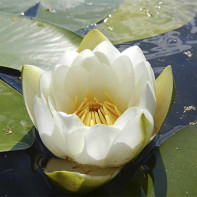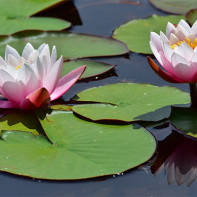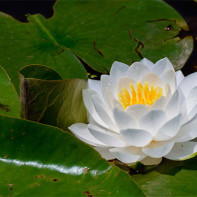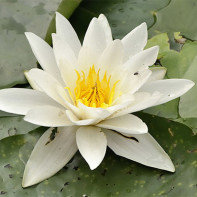Water lily: medicinal properties and contraindications
Botanists call the water lily the beautiful word "nymphaea." Romantic! It immediately seems like a nymph - a wonderful fairy tale creature - frolics on the shore of a reservoir, the water surface of which is covered with magnificent, lily-like flowers. People came up with a water lily no less beautiful name - mermaid color. Despite the fact that the nymphaeum is unpretentious and is found almost everywhere, today this plant is listed in the Red Book, as it is mercilessly exterminated by people.
- Chemical composition
- How it looks and where it grows
- Kinds
- Collection and storage
- What is the difference between a water lily and a lotus?
- Growing Features
- The healing properties of water lilies
- Water lily in folk medicine
- Soothing infusion
- Broth from heat
- With heart weakness
- From skin inflammation
- For muscle pain
- "Mustard" for colds
- Dandruff Rinse
- Types of healing compounds
- Infusion
- Tincture
- Decoction
- Contraindications
- Interesting facts about the water lily
Chemical composition
- The rhizome contains a large amount of nutrients: it is starch, sugar and protein.
- The following important components of the waterlily root are tannins (by the way, they are also present in leaves and seeds). For the plant itself, they are necessary, as they prevent rhizome rot, which is quite possible due to the constant presence in the water. For the human body, tannins are useful for several reasons at once. They help fight digestive disorders, diarrhea and dysbiosis, are able to suppress the reproduction of microbes and remove toxins and waste from the body, including after radiation exposure. They also have hemostatic and anti-inflammatory abilities.
- The gum contained in the plant’s roots also works to cleanse the body, and the tartaric acid and gallic acid present in it with natural antioxidants help to improve metabolic processes in the body. Resins stimulate the strengthening of immunity, help fight inflammation and are involved in the work of the respiratory and cardiovascular systems.
- Flowers and leaves contain many flavonoids, the spectrum of action of which is very wide - from vasoconstrictor and immunomodulating to anticarcinogenic, hypoallergenic and antioxidant.
- However, the water lily contains a number of substances that allow it to be considered dangerous. These are glycosides and alkaloid nymphine. On the one hand, their uncontrolled use is fraught with poisoning, expressed in violations of the nervous and cardiovascular systems. On the other hand, at a therapeutic dosage, glycosides are able to relieve tachycardia, improve blood circulation and establish cardiac activity. Alkaloids, in recommended doses, are used to anesthetize, stop bleeding, raise the body tone, and treat nervous diseases and diseases of the heart and blood vessels.
How it looks and where it grows
The rhizome of the water lily is thick, white with black "nicks." It spreads over the surface and inside the bottom sediments, attaching to them with long and thin, but strong roots. The plant has no stem, leaves and pedicels grow immediately from the root.
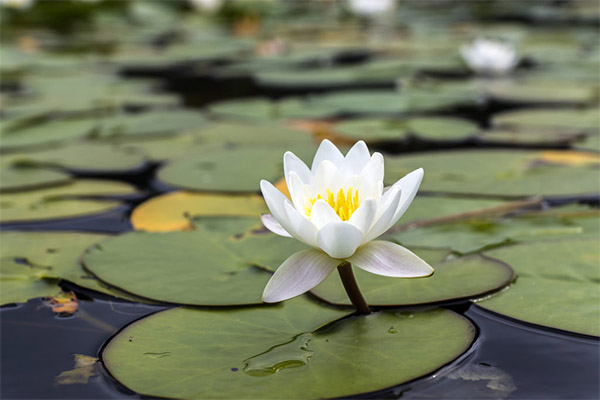
The leaves of the plant are like a heart, they are quite dense, have a dense green color and float in a straightened horizontal form on the water surface. The width of the leaves can vary from 25 to 35 cm.
The nymphaea blooms from the beginning to the end of summer, its flowers are quite large, in the open form they can reach 20 cm in diameter. They are also located on the surface of the water.
The flowers are lush, double because of the large number of oval-shaped petals with pointed tips. Mostly in nature, there is a water-lily of snow-white color, gradually acquiring a yellowish color towards the center, in the very middle of which yellow-golden stamens are located. The gentle but persistent smell of nymphaea can spread to the area around the pond or lake in which it grows.
The fruit of the water lily has an oval shape and looks like a small pitcher, hence the name of the plant. The fruit fully ripens under water, there it opens and releases seeds, covered with a thick slippery layer, due to which they hold on the surface. Gradually, this layer erodes, the seeds swell, become heavier and slowly sink to the bottom of the reservoir, where they hatch and grow.
The nymphaeum grows in lakes and ponds with stagnant water or in quiet creeks of slowly flowing rivers at a depth of no more than 2 m. In the natural environment, it can be found in all countries of the planet, with the exception of polar and polar regions. Florists brought out many water lilies of different colors, which are used in landscape design and decorate decorative ponds with them.
Kinds
Water lily strikes with a variety of shades and colors that exist in nature. Today, there are about 50 varieties of this flower.
White water lily
It occupied the entire territory of Eurasia, and its water colonies are also frequent in Africa. This water lily is large, it has leaves with a diameter of about 35 cm, and also flowers of impressive size, reaching up to 20 cm across, they have a slightly milky color. The plant has a strong and tenacious root system that extends along the bottom surface, but penetrates the sludge with its elongated processes. In length, the root will grow to 65 cm.
Under the surface of the water, the stems grow in a large bush, so one plant of water lilies can settle down quite freely and take up a lot of space in the lake or pond.
A white nymphaea blooms for three weeks, alternately throwing one white water lily after another.
Water Lily
In its appearance, the water nymphaeum resembles a white water lily. The leaves floating on the surface are of medium size, and the foliage that is under water is small. Cream medium-sized flowers with a bright yellow center lie on the surface of the water mirror of the reservoir. Pharmacology uses a water lily.
Blue water lily
It is believed that this species appeared one of the first, it has other names - the Egyptian lotus, or Egyptian lily. This water lily went to spread around the world from the Nile, the largest African river, first across Africa itself, then advanced to Thailand and India. Its leaves are quite wide - about 35 cm, powerful veins quite clearly visible on them. Against their background, her flowers of no more than 20 cm make an impression of small ones. Shades of petals in one flower can be either sky blue or purple, cornflower blue and bright blue.
Water lily red
Its flower is characterized by an original and beautiful color - from deep pink to pure red. Small flowers, with a diameter of 12 cm or more, spread a delicate, steady aroma. The root is shallow in the ground. It is branched; a number of additional branches depart from the main stem. Bright green fleshy succulent leaves reach 25 cm across.
Tiger water lily
It got its name because of the uneven coloring of dark green leaves, a pattern of red-brown and brown spots that resemble tiger stripes. The root system, like all water lilies, is powerful, well developed. Botanists believe that the homeland of this type of water lily is hot Africa, therefore it is one of the most demanding types of nymphaea to heat; it does not tolerate cold water, rapid currents and frosts. Her flowers are white or slightly creamy, compact.
Victoria Regia, or the Amazonian Nymphaeum
This type of water lily has the most impressive size. Its flower, which has blossomed to the end, reaches 35 cm, and from the beginning of flowering to completion, it acquires all the gentle shades - from snow-white to pure pink. It blooms once a year and blooms only at night. The smell of Victoria Regia is quite persistent, memorable. On a huge sheet of water lilies - up to 2 m in diameter - a teenager can easily lie down, and the sheet with the edges wrapped up will support its weight, it won’t drown.
Victoria Regia was discovered relatively recently - in the 19th century in the Amazon. Today it is cultivated in different countries of the world, including Russia.
Water lily yellow
The yellow water lily is a perennial wintering well in the middle lane. The root system of the plant is well developed, the roots are located deep in the ground. The leaves located under water are small, have an uneven edge and are located on shortened petioles.
Leaves floating on the water surface are ovoid in shape, up to 20 cm across. Flowers 17 cm in diameter have a green tint outside, they are yellow inside. Such a water lily blooms for a long time - from June to September.
Collection and storage
Traditional healers for the preparation of medicinal compounds use all parts of the water lily - from rhizomes to seeds.
Rhizomes begin to be harvested when a plant enters a flowering season. Although the largest amount of nutrients and nutrients accumulates closer to the fall. Collecting it at the bottom of the pond, you do not need to take everything clean, a significant part of the roots must be left so that the nymphaeum does not completely disappear. Usually, to get medicinal raw materials from the bottom, they use hooks.
The rhizomes taken from the day must be cleaned of small thin roots, washed and cut into small pieces, which are then laid out under a canopy, in a draft, but so that the sun's rays do not fall on the medicinal raw material. At the same time, you can prepare flowers and buds. You need to leave for the buds until seven in the morning, before they have time to open. The flowers are best applied immediately fresh, but if there is a great need, they can be dried under the same conditions as the roots - in the shade and in the draft.
There are usually no problems with leaf harvesting: they can be cut from spring to cold autumn. Dry the raw materials under the roof, in a room with good ventilation.
Seeds are easy to collect from the surface of a pond or lake and then dried under unchanged conditions: in the shade.
Each type of medicinal raw material - roots, leaves, flowers and seeds - is stored in a separate paper bag in a dry room, in such conditions they retain their healing qualities for two years.
What is the difference between a water lily and a lotus?
Outwardly, both plants are beautiful - both the lotus and the water lily. A water lily unites a whole group (over fifty varieties) of plants of the Nymphaeum family growing in water. Lotus has only two types - yellow and nutty.
The most noticeable difference in leaves and flowers. At the water lily, they lie horizontally on the surface of the water, while the lotus vigorously and rather high above the water holds its rising leaves and flowers.
The shape of the leaves of these two plants also differ: in the water lily they are flat, with a smooth edge, and in the lotus they have the shape of a shallow bowl with a wave along the edge of the cut.
In general, the flowers are distinguishable. The nymphaea have narrower petals than the lotus, more of them, which is why each flower looks terry. And the lotus, in contrast to the water lily, has a large, noticeable seed box.
If we compare the places of plant growth, it should be noted that there is a water lily almost everywhere. Compared to her, the Lotus is a real aristocrat who needs special conditions for a normal life - a long warm summer and plenty of sunshine. Therefore, on the territory of the Russian Federation it can be found in the Astrakhan region and the water basin of the Caspian Sea.
Growing Features
Since the water lily is unusually beautiful, it is understandable the desire of each summer resident to grow such a miracle on his site. It is easy to create favorable conditions for this.
Experienced gardeners recommend avoiding stint and buying planting material in good, proven stores for gardeners or from reliable, well-known gardeners to avoid disappointment.
Plant a water lily in the summer when the weather is warm. It is better to plant it not in the soil of a reservoir, but in a large pot so that in autumn it can be easily removed and carried away for wintering.Many plants do not need to be rooted in a small pond.
It is better to buy special soil for planting, if it was not available for sale, you can pour 4-5 cm of peat and at least 10 cm of turf land mixed with sand to the bottom of the landing tank. The growth point cannot be buried in the ground. During planting, the balls of clay, in which mineral fertilizers are mixed, must be stuck to the roots of the water lily. They will feed the plant throughout the season. Pour pebbles in the top layer in the planting pot so that the container does not float. Pots to lower to the bottom of the reservoir: dwarf varieties should grow at a depth of 50 cm, the rest - 1 m and deeper. But, in order for the plant to grow faster, leave it in shallow water before the first leaves appear.
For the nymphaeum to grow normally, special work is not required. It is important to prevent too rapid growth of leaves, because of this, the flowers can be chopped. It is necessary to leave each plant no more than three leaves, pick the rest. The pond must be cleaned every season. In autumn, after harvesting water lilies for the winter, water is drained, the walls of the reservoir are scrubbed from growths, washed, and in the spring clean water is poured into it.
The water lily is a little sick, because it has a very strong immunity. Insects attack it also rarely. But in the heat in small reservoirs with stagnant water, a beetle called a water lily leaf beetle can settle. Its larva eats the leaves of the plant. The pest must be collected manually, and damaged leaves should be removed. It is better not to use chemical protective equipment, since they kill all living things in water.
May attack water lily and aphids. It not only spoils the leaves, but also destroys the flowers - at first it worsens their appearance, and then completely provokes its early flowering. There is only one way to combat it - flushing the pest with water.
The healing properties of water lilies
Official medicine uses a water lily. It is included in the complex multicomponent collection of Zdrenko, which is used to treat anacid gastritis and papillomatosis of the bladder.
Thanks to the substances that make up the plant, it has anti-inflammatory, astringent and antibacterial effects, it can reduce fever, stop blood, reduce pain, lower blood pressure, calm and cause sleep. In addition, the lily has a laxative effect, a choleretic and diuretic effect.
Water lily in folk medicine
Traditional medicine uses a water lily quite widely. In the list of diseases in which healers prescribe funds based on it, in addition to the common cold, there are more serious ones such as tuberculosis, tumors, hepatitis, diarrhea and dysentery.

It saves the nymphaeum from diseases of the urinary and reproductive systems - kidneys, bladder (including cystitis), gonorrhea, it is recommended for whitewash. With skin problems, a water lily also helps well, in particular, it treats purulent wounds, abscesses, ulcers, boils and boils, and also relieves inflammation of the epidermis. The plant is used to get rid of seizures of various origins, disorders of the nervous system, in particular from neurosis, neuralgia, with its help it is removed from depressive states.
Water lily helps relieve toothache and rheumatic pains, is used in cosmetology to treat dandruff and improve hair composition, whiten skin and brighten freckles.
Traditional healers use rhizomes and flowers of a white water lily for the preparation of medicinal compositions, and each dosage form has a specific purpose. So, decoctions are prepared from flowers, which are used as an adjuvant in the treatment of jaundice, as well as as a laxative. Infusion of petals fight insomnia, use it to alleviate the condition during fever. Kidney and bladder are used to treat rhizome broth; they are used for the quick healing of putrefied scratches and wounds, as well as a therapeutic and prophylactic for hair loss.
Soothing infusion
Heat half a liter of water to a boil and pour 2 tablespoons of the waterlily petals with it. Leave to infuse for 50-60 minutes, then filter. Infusion is used as a sedative and sleeping pill. Recommended daily allowance - 4 times after a meal of 30 ml.The course of treatment is designed for a month.
Broth from heat
For 400 ml of water, you need a tablespoon of petals. Pour the healing plant with boiled water and leave it in a water bath so that the composition lasts for a quarter of an hour. Remove the broth and set aside for another half hour. Strain when it cools slightly, and take 100-120 ml, if the temperature rises.
With heart weakness
Mix the petals of the water lily and the ripe fruits of the hawthorn equally. Take a tablespoon of the resulting drug collection and pour it with 300 ml of boiling water. Leave for 3 hours to well insisted. Filter and drink twice a day for 50 ml, continue treatment from 21 to 30 days.
From skin inflammation
Pour 3 tablespoons of chopped water lily leaves with half a liter of boiled water, leave for half an hour. Filter the liquid and wet it with a soft cotton cloth or gauze, folding it in several layers. Apply tissue to the sore spot for about 20 minutes. This remedy is effective not only for inflammation of the skin, but also for purulent rashes. If you repeat the procedure 3 to 5 times a day, healing will go pretty quickly.
For muscle pain
Scalp with a small amount of boiling water the flowers of a water lily (3 tablespoons) and leave it under a closed lid to swell. Then wrap them in a cotton cloth or cheesecloth and place on a problem spot. Keep the compress from half an hour to an hour.
"Mustard" for colds
To make mustard plasters, the root of the water lily must be ground. Fresh can be sent to the blender immediately, first dried steam in hot water. Put the resulting slurry on a cotton cloth and put on the back or chest in front. A good effect will be obtained if honey is added to the gruel for the mustard. First cover the mass with plastic wrap or wax paper, and then cover yourself with a blanket or a warm shawl. Warm up the patient using such a product for at least an hour, then wash off his traces (juice, drops of honey) from the skin.
If the pulp is made from fresh root, you can treat not only a cold in this way, but also alleviate the condition with radiculitis, repeating the procedure until the back pain passes.
Dandruff Rinse
You can treat dandruff with a decoction of the petals of a water lily, which must be previously kneaded. Heat the water (400 ml) to a boil, pour the medicinal herb with it and boil for a quarter hour, then cool, strain. Rinse hair after shampooing with your usual shampoo. It not only eliminates dandruff, but also relieves skin inflammation.
Types of healing compounds
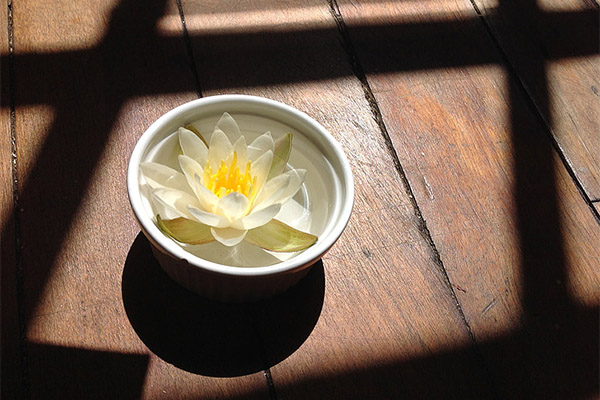
Infusion
To prepare the infusion, you will need flowers and leaves of a white water lily. Grind both ingredients, take a tablespoon and pour into a thermos, then pour the medicinal plant 0.5 liters of boiled water. Keep the composition with a water lily in a thermos all night, filter in the morning. It will turn out to be an excellent skin care product: you can also fight freckles, lighten a tan, and treat acne. Wipe the face with infusion 2 to 3 times a day.
Tincture
Tincture from the root of a white water lily is made in a proportion of 1:10, that is, half a liter of vodka needs 50 grams of chopped medicinal raw materials. Infuse the composition for 14 days without access to sunlight, shaking the bottle daily. Filter and store in a cool dark place.
This tool is recommended in the complex treatment of tumors, it shows especially good results in the treatment of the spleen. The treatment regimen - 20 drops three times a day without reference to food intake.
Decoction
To prepare a multifunctional broth, you will need 5 grams of dried and crushed root of a white water lily. Pour it into a mug in which a glass of water is boiled.Put the mug in a water bath, hold it from the moment of boiling for 20 minutes, remove and cool. Strain after cooling. Such a decoction is recommended inside with neurosis. Divide the liquid into two portions and take one in the evening, the second in the morning. Coursework - 21 days.
Outwardly, the composition is applied in the form of lotions if the skin is burned in the sun or thermal burns are received, as well as for the treatment of skin cracks and festering scratches. It is necessary to moisten the soft tissue with a decoction and put on sore spots, keep the lotion for at least 15 minutes. The procedure must be repeated from 3 to 6 times a day.
Contraindications
Healing preparations based on a water lily should be used with caution, since it contains toxic substances. Before ingestion, it is necessary to consult a doctor and in no case exceed the recommended dosage.
It is forbidden both the internal and external use of the water lily for children, pregnant women and mothers who are breast-feeding a baby.
Since water lily formulations have the ability to reduce pressure, hypotonics cannot be taken. Individual intolerance of both the whole plant and its individual components is also possible.
Interesting facts about the water lily
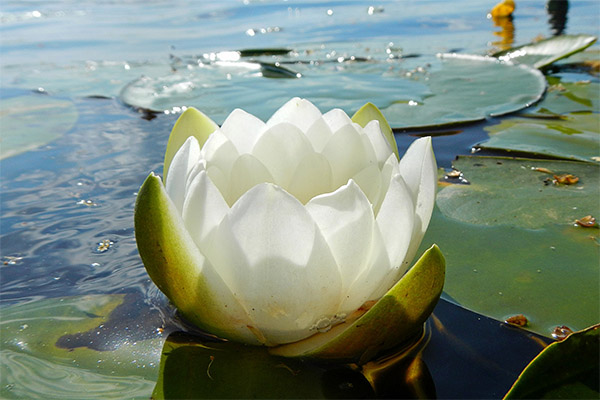
- Studies of ancient fossils indicate that the water lily is one of the earliest flowering plants.
- The water lily has an interesting feature: closing at night, it can sink under the water, where it restores freshness on the eve of the next day.
- Our ancestors noted that the behavior of water lilies is directly dependent on the weather. If the flowers opened early in the morning - the weather promises the sun all day, if it appeared from under the water no earlier than nine hours, you have to wait for rain, and if it does not rise to the surface at all, a downpour is sure to come.
- Water lily can be a substitute for individual foods. So, its rhizomes are rich in starch and can be used both for its manufacture and for the production of flour, for which it is necessary to remove tannins from them by soaking. And if you fry the water lily seeds, they are quite capable of becoming a substitute for coffee.
- The water lily, or nymphaea, was named after an ancient Greek legend that tells how one nymph, who fell in love without reciprocity, threw herself into the waters, where she perished forever and turned into a beautiful flower.
- In the ancient Slavs, the water lily was necessarily included in love potions as a component.
«Important: all information on the site is provided exclusively in fact-finding purposes. Before applying any recommendations, consult with a profile specialist. Neither the editors nor the authors are liable for any possible harm caused materials. "


